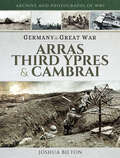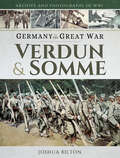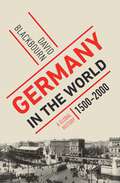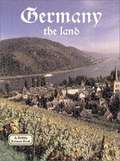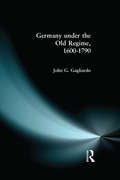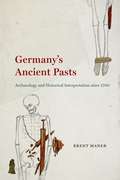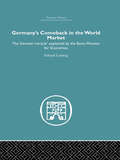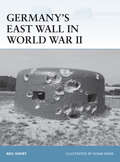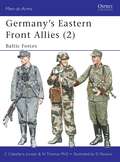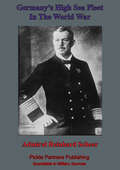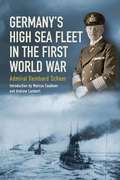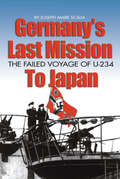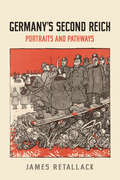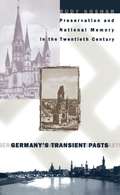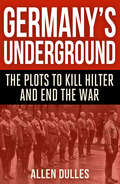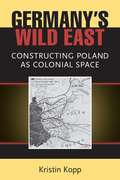- Table View
- List View
Germany in the Great War: Arras, Third Ypres & Cambrai (Germany In The Great War Ser.)
by Joshua BiltonThis book documents the experiences of the Central Powers, specifically Austria-Hungary, Germany and the Ottoman Empire during 1917, as they fought on land, at sea and in the air. Drawing on hundreds of contemporary photographs, many of them never previously published, this book examines the experiences of these three nations, spotlighting not only the events that occurred throughout the year, but the lives of those individuals fighting and dying to defend their homelands, families and friends. Each chapter includes a succinct overview of a single front or theatre of operation, complimenting the hundreds of professional and amateur photographs contained within. Though many of the images are of the German and Austro-Hungarian armies on the Westfront and Ostfront, several additional chapters also explore the fighting across other, lesser-known fronts, including the Südwest Front and in Sinai and Palestine, and Mesopotamia. This book is an excellent pictorial guide that would be of benefit to anyone seeking to gain a better understanding of what life was like from the perspective of the German, Austro-Hungarian and Ottoman armies, and their peoples during the fourth year of the First World War.
Germany in the Great War: Verdun & Somme (Germany In The Great War Ser.)
by Joshua BiltonFor the Central Powers, 1916 was a year of trial and error, of successes and failures, of innovation and of drastic changes. Tactics developed, while war aims mutated to suit the inertia of trench warfare. Advances were effectively countered with the development of new weaponry, or indeed aided by their inclusion. Across all fronts, whether at home or in Poland, citizens and soldiers alike stood fast against Entente forces. On the Western Front, bitter fighting continued apace. To the east the armies of Austro-Hungary, Germany and Bulgaria battled Entente forces. Meanwhile at sea, the German High Seas Fleet ambushed the Royal Navy off the coast of Denmark. On the Home Front, the poor harvest of 1916, coupled with a lack of transport, led to a winter of stark deprivation. As a consequence, the German government introduced what was effectively a system of rationing entitled, ‘sharing scarcity.’ While to the south, Ottoman forces fought Allied soldiers for control of Kut and Erzurum, a fortified trading port in eastern Turkey. Germany in the Great War: Verdun & Somme is the third publication in a five-part series. In addition to the author’s introduction and a chronology of events, five hundred contemporary photographs, many of which have never before been published in this country, are included.
Germany in the Twentieth Century (Routledge Library Editions: German Politics)
by David ChildsThe book traces the development of Germany from the Kaiser’s Reich in the 1870s to the reunited democratic state led by Helmut Kohl in the 1990s. The author begins by countering the popular view of Germany before 1914 as irredeemably reactionary, and after assessing Germany’s part in the First World War, he outlines the rise and fall of the Weimar Republic. The 12 years of Hitler’s destructive experiment are presented in a balanced way as part of the overall development of the country. Germany in defeat is then discussed, as is heer rebirth under Four Power occupation. The last chapters explore the two separate German states and the events leading up to the restoration of German unity.
Germany in the World: A Global History, 1500-2000
by David BlackbournBrilliantly conceived and majestically written, this monumental work of European history recasts the five-hundred-year history of Germany. With Germany in the World, award-winning historian David Blackbourn radically revises conventional narratives of German history, demonstrating the existence of a distinctly German presence in the world centuries before its unification—and revealing a national identity far more complicated than previously imagined. Blackbourn traces Germany’s evolution from the loosely bound Holy Roman Empire of 1500 to a sprawling colonial power to a twenty-first-century beacon of democracy. Viewed through a global lens, familiar landmarks of German history—the Reformation, the Revolution of 1848, the Nazi regime—are transformed, while others are unearthed and explored, as Blackbourn reveals Germany’s leading role in creating modern universities and its sinister involvement in slave-trade economies. A global history for a global age, Germany in the World is a bold and original account that upends the idea that a nation’s history should be written as though it took place entirely within that nation’s borders.
Germany the Land (Lands, Peoples, and Cultures Ser.)
by Kathryn LaneIntroduces the geography, cities, transportation, economy, and wildlife of Germany.
Germany through Jewish Eyes: A History from the Eighteenth Century to the Present
by Shulamit VolkovWhat can Jewish history tell us about German history? How can we understand the history of modern Germany from a Jewish perspective? And how do we bring the voices of German Jews to the fore? Germany through Jewish Eyes explores the dramatic course of German history, from the Enlightenment, through wars and revolutions, unification and reunification, Nazi dictatorship, Holocaust, and the rebuilding of a prosperous, modern democracy - all from a Jewish perspective. Through a series of chronologically ordered life-stories, Shulamit Volkov examines how the lived experience of German Jewry can provide new insights into familiar events and long-term developments. Her study explores the plurality of the Jewish gaze, considering how German Jews sought full equality and integration while attempting to preserve a unique identity, and how they experienced security and integration as well as pronounced hatred. Volkov's innovative study offers readers the opportunity to look again at the pivotal moments of German history with a fresh understanding.
Germany under the Old Regime 1600-1790
by John G. GagliardoGerman history in the seventeenth and eighteenth centuries is notoriously inaccessible to non-specialists. When other European countries were well on the way to becoming nation states, Germany remained frozen as a territorially-fragmented, politically and religiously-divided society. The achievement of this major contribution to the new History of Germany is to do justice to the variety and multiplicity of the period without foundering under the wealth of information it conveys.
Germany without Bismarck: The Crisis of Government in the Second Reich, 1890 - 1900
by J. C. RohlThis title is part of UC Press's Voices Revived program, which commemorates University of California Press’s mission to seek out and cultivate the brightest minds and give them voice, reach, and impact. Drawing on a backlist dating to 1893, Voices Revived makes high-quality, peer-reviewed scholarship accessible once again using print-on-demand technology. This title was originally published in 1967.
Germany's Ancient Pasts: Archaeology and Historical Interpretation since 1700
by Brent ManerIn Germany, Nazi ideology casts a long shadow over the history of archaeological interpretation. Propaganda, school curricula, and academic publications under the regime drew spurious conclusions from archaeological evidence to glorify the Germanic past and proclaim chauvinistic notions of cultural and racial superiority. But was this powerful and violent version of the distant past a nationalist invention or a direct outcome of earlier archaeological practices? By exploring the myriad pathways along which people became familiar with archaeology and the ancient past—from exhibits at local and regional museums to the plotlines of popular historical novels—this broad cultural history shows that the use of archaeology for nationalistic pursuits was far from preordained. In Germany’s Ancient Pasts, Brent Maner offers a vivid portrait of the development of antiquarianism and archaeology, the interaction between regional and national history, and scholarly debates about the use of ancient objects to answer questions of race, ethnicity, and national belonging. While excavations in central Europe throughout the eighteenth and nineteenth centuries fed curiosity about the local landscape and inspired musings about the connection between contemporary Germans and their “ancestors,” antiquarians and archaeologists were quite cautious about using archaeological evidence to make ethnic claims. Even during the period of German unification, many archaeologists emphasized the local and regional character of their finds and treated prehistory as a general science of humankind. As Maner shows, these alternative perspectives endured alongside nationalist and racist abuses of prehistory, surviving to offer positive traditions for the field in the aftermath of World War II. A fascinating investigation of the quest to turn pre- and early history into history, Germany’s Ancient Pasts sheds new light on the joint sway of science and politics over archaeological interpretation.
Germany's Cold War: The Global Campaign to Isolate East Germany, 1949-1969
by William Glenn GrayUsing newly available material from both sides of the Iron Curtain, William Glenn Gray explores West Germany's efforts to prevent international acceptance of East Germany as a legitimate state following World War II. Unwilling to accept the division of their country, West German leaders regarded the German Democratic Republic (GDR) as an illegitimate upstart--a puppet of the occupying Soviet forces. Together with France, Britain, and the United States, West Germany applied political and financial pressure around the globe to ensure that the GDR remain unrecognized by all countries outside the communist camp. Proclamations of ideological solidarity and narrowly targeted bursts of aid gave the GDR momentary leverage in such diverse countries as Egypt, Iraq, Ghana, and Indonesia; yet West Germany's intimidation tactics, coupled with its vastly superior economic resources, blocked any decisive East German breakthrough. Gray argues that Bonn's isolation campaign was dropped not for want of success, but as a result of changes in West German priorities as the struggle against East Germany came to hamper efforts at reconciliation with Israel, Poland, and Yugoslavia--all countries of special relevance to Germany's recent past. Interest in a morally grounded diplomacy, together with the growing conviction that the GDR could no longer be ignored, led to the abandonment of Bonn's effective but outdated efforts to hinder worldwide recognition of the East German regime.
Germany's Comeback in the World Market: the German 'Miracle' explained by the Bonn Minister for Economics
by Ludwig ErhardA great deal has been talked about the economic recovery of Western Germany since the Second World War. It is know htat this recovery was accompanied by the return of the Federal Republic to the markets of the world. Not so much is know abotu the details - about the work effected through the opitimism of the Minister for Economics, Professor Ludwig Erhard. In this book, the minister himself speaks. A detailed description is given of the stages by which first the Bizone, and then the Federal Republic, has effected the remarkable comeback which has created keen interest and concern. The book goes into the full detail which might be expected from on who is in charge of the entire machinery. The description of the way in which Government policy was employed to stimulate a free market economy is of great technical interest. Equally important is the detailed description of the way in which every nook and cranny is exploited to give the Federal Republic a foothold in foreign markets. No opportunity is neglected, from the fostering of the most ambitious long-term capital development schemes to the publication of day-to-day reports on trade openings. This book was first published in 1954.
Germany's Drive to the West (Drang Nach Westen): A Study of Germany's Western War Aims during the First World War
by Hans W. GatzkeOriginally published in 1950. Hans Gatzke analyzes Germany's ambitions to expand westward during World War I. Germany's wartime plans for expansion to the west had important repercussions at home and abroad. Gatzke proceeds chronologically, starting with the German political parties' outlining of their war aims. Gatzke claims that a combination of interests, including those of industrialists, pan-Germans, the parties of the Right, and the Supreme Command was responsible for the stubborn propagation of Germany's large war aims, which condemned the German people to remain at war until the bitter end. Each of these forces had its own particular reasons for wanting to hold out for far-reaching territorial gains, yet one aim that most of them had in common was ensuring, through a successful peace settlement, the continuation of the existing order, to their own advantage and to the political and economic detriment of the majority of the German people.
Germany's East Wall in World War II
by Adam Hook Neil ShortThe East Wall was where the final battles for the stricken Third Reich were fought, amid scenes of utter carnage. Beginning life at the end of World War I, the wall became a pet project of Adolf Hitler's, whose ascent to power saw building work accelerated, with plans for a grand, 'Maginot-style' defence put in place. But with a characteristically erratic change of heart, Hitler began to systematically strip the wall of its best defensive assets to bolster the Atlantic Wall, never dreaming that he would face an attack on two fronts. Despite belated and somewhat bungled reinforcements later in the War, the Eastern Wall would face a monstrous challenge as it became the Reich's last redoubt in the face of the mighty Soviet war machine. Neil Short brings his expert knowledge to bear with an analysis of different stages of the wall's construction, the years of neglect and decay and the hasty, drastic redevelopment in the face of the looming Soviet threat.
Germany's Eastern Front Allies
by Nigel Thomas Darko PavlovicThe Baltic nations - Estonia, Latvia and Lithuania - enjoyed a brief independence between the World Wars before being annexed by the USSR in 1940 during World War II. The grim experience of Soviet occupation made it inevitable that after the German invasion of Russia in 1941 they would fight beside the Wehrmacht as allies against the Red Army while always hoping for restored independence. That hope was crushed again in 1944-45; yet 'Forest Brother' guerrillas continued to fight against hopeless odds for years after the second Soviet occupation. This extraordinary story is illustrated here with rare photos, insignia charts, tables of units and detailed uniform plates.
Germany's Hidden Crisis: Social Decline in the Heart of Europe
by Oliver NachtweyAn excellent study of how neoliberalism is causing a crisis in GermanyOne of the German-speaking world's leading young sociologists lays out modern Germany's social and political crisis and its implications for the future of the European hegemon. Upward social mobility represented a core promise of life under the "old" West German welfare state, in which millions of skilled workers upgraded their VWs to Audis, bought their first homes, and sent their children to university. Not so in today's Federal Republic, however, where the gears of the so-called "elevator society" have long since ground to a halt. In the absence of the social mobility of yesterday, widespread social exhaustion and anxiety have emerged across mainstream society. Oliver Nachtwey analyses the reasons for this social rupture in post-war German society and investigates the conflict potential emerging as a result, concluding that although the country has managed to muddle through the Eurocrisis largely unscathed thus far, simmering tensions beneath the surface nevertheless threaten to undermine the German system's stability in the years to come.
Germany's High Sea Fleet In The World War (Barnes and Noble Digital Library)
by Anon. Admiral Reinhard ScheerIncludes 26 illustrations, battle maps and portraits of the Naval War 1914-1918Known to his own sailors as the "Man with the Iron Mask", Admiral Reinhard Scheer was a hardened dedicated sailor. It was his relentless drive that enabled him to overcome his limited social background and gain the highest rank in the Kaiserliche Marine. His memoirs are of great interest to historians of the First World War and the nascent German 'Great Power' status.Broadly divided into three sections, the first part of his memoirs concentrates on the German Fleet's activities during the first years of the war, including the bombardment of the coast of Britain, which came as such a shock to the Allies. The second, which naturally dominates his memoirs, are his great exploits at the Battle of Jutland or Skaggerak in command of the cruiser squadron which caused such damage to the British Fleet. The third and final part recounts his time as chief of staff of the German Navy, as an advocate of unrestricted Naval Warfare he recounts his lobbying of the Emperor and the methods and experiences of the U-Boats under his command.A thoroughly gripping Naval read.Author -- Admiral Reinhard Scheer (1863-1928)Translator -- Anon.Text taken, whole and complete, from the edition published in New York [etc.] Cassell and company, ltd., 1920.Original Page Count - xiv and 375 pages.
Germany's High Sea Fleet in the World War
by Reinhard ScheerAnglo-German naval rivalry before 1914 had been expected to culminate in a cataclysmic fleet action in the North Sea once war was declared, a battle upon which the outcome of the war would depend: yet the two fleets met only once, at Jutland in 1916, and the battle was far from conclusive. In his own account of the war in the North Sea, first published in 1920, Admiral Scheer, the German commander at Jutland, gives his own explanation for the failure of either fleet to achieve the decisive victory expected of it, particularly the failure of his own operation plans that resulted in the battle of Jutland. This book is an invaluable account of one of the most important theatres of the First World War, written by one of its most senior commanders.
Germany's Last Mission to Japan
by Joseph Mark ScaliaWhen U-234 slipped out of a Norwegian harbor on her maiden voyage in March 1945, the submarine carried a precious assortment of armaments and a select group of officials destined for Japan. En route came word that Germany had surrendered, and the boat's commander, Johann Heinrich Fehler, suddenly found himself in a rogue submarine. U-234 was not only loaded with the most technically advanced weaponry and electronic detection devices of the era, but also two Japanese naval officers still at war with the Allies who preferred death to surrender. This dramatic account of the fateful voyage offers an intriguing look at the individuals involved. Until now, the legacy of U-234 has centered on her ominous cargo, including 560 kilograms of uranium oxide, the presence of which has been the focus of countless theories and conjecture.With this book Joseph Mark Scalia argues that the submarine's value lies not in her inanimate cargo but in the individuals accompanying the material to Japan. Through exhaustive research into U.S. Navy interrogation records, European and Japanese archives, and interviews with former U-234 crewmembers and other principals, Scalia has produced a fascinating portrait of proud warriors coping with defeat. Among them was a high-ranking naval judge sent to Tokyo to purge the residual elements from an infamous spy ring, an anti-aircraft and air defense expert, a top naval construction engineer, a radar expert, a Messerschmitt designer who later became project manager for the F-105 Thunderchief, and a Luftwaffe general who directed the 1939 aerial blitz of Poland and was implicated in the 1944 plot to assassinate Hitler.Because this is the first book to be solely devoted to U-234, it also provides a thorough examination of the 1600-ton Type XB minelaying submarine, from launch to surrender on 15 May 1945 to an American destroyer. In addition, the work evaluates the technology carried aboard--an actual ME-262 fighter and masking measures for submarines were included--and places the mystery of the uranium oxide cargo in perspective.
Germany's New Security Demographics
by Wenke AptMilitary recruitment will become more difficult in times of demographic aging. The question arises whether demographic change will constrain the capacity of aging states like Germany to conduct foreign policy and pursue their national security interests. Since contemporary military operations still display a strong human element, particular scrutiny is given to the empirical analysis of the determinants of military propensity and military service among youth. An additional human capital projection until 2030 illustrates how the decline in the youth population will interact with trends in educational attainment and adolescent health to further complicate military recruitment in the future. A concluding review of recruiting practices in other NATO countries provides insight in best-practice policy options to reduce the military's sensitivity to demographic change. Following this approach, the book gives prominence to a topic that has thus far been under-represented in the greater discussion of demographic change today, namely the demographic impact on international affairs and strategic calculations.
Germany's Second Reich
by James RetallackDespite recent studies of imperial Germany that emphasize the empire's modern and reformist qualities, the question remains: to what extent could democracy have flourished in Germany's stony soil? In Germany's Second Reich, James Retallack continues his career-long inquiry into the era of Bismarck and Kaiser Wilhelm II with a wide-ranging reassessment of the period and its connections with past traditions and future possibilities.In this volume, Retallack reveals the complex and contradictory nature of the Second Reich, presenting Imperial Germany as it was seen by outsiders and insiders as well as by historians, political scientists, and sociologists ever since.
Germany's Transient Pasts
by Rudy J. KosharOver the course of the twentieth century, Germans have venerated and maintained a variety of historical buildings--from medieval fortresses and cathedrals to urban districts and nineteenth-century working-class housing. But the practice of historic preservation has sometimes proven controversial, as different groups of Germans have sought to use historical architecture to represent competing versions of their nation's history.Transient Pasts is the first book to examine the role that the historic preservation movement has played in German cultural history and memory from the end of the nineteenth century to theearly 1970s.Focusing on key public debates over historic preservation, Rudy Koshar charts a trajectory of cultural politics in which historical architecture both facilitated and limited Germans' efforts to identify as a nation. He demonstrates that historical buildings and monuments have served as enduring symbols of national history in a country scarred by the traumas of two world wars, Nazism, the Holocaust, and political division. His findings challenge both the widely accepted argument that Germans have constantly repressed their past and the contention that Germany's intense public engagement with history since reunification is unprecedented.
Germany's Underground
by Allen DullesGermany's Underground, first published in 1947, is the classic inside look at German resistance movements attempting to overthrow Adolph Hitler and the Nazi regime. Author Allen Dulles, younger brother of John Foster Dulles, was the OSS chief of station in Bern Switzerland, and had extensive personal contacts with members of the German underground. Following the war's end, he was stationed in Germany, providing him with access to captured secret Nazi documents. He was also able to interview the handful of surviving men and women involved in attempts to overthrow the Nazis or assassinate Hitler. Germany's Underground is a fascinating look at the individuals involved in the German resistance as well as an examination of morality and ethics in the midst of a brutal police state. Allen Dulles was appointed director of the U.S. CIA in 1953, a position he held until 1961. Dulles, born in 1893, passed away in 1969.
Germany's Vision of Empire in Venezuela: 1871-1914
by Holger HerwigThe author details Imperial Germany's interests in Venezuela (and all South America) from the ascension of Wilhelm II to the outbreak of WWI.
Germany's War and the Holocaust: Disputed Histories
by Omer BartovWhile attempts to come to terms with past catastrophe . . . can help prevent its recurrence, they may also provide arguments for . . . actions against the real or imagined perpetrators of previous disasters. The confrontation with . . . catastrophe can help us understand the roots and nature of this century's destructive urges, as well as humanity's extraordinary recuperative capacities; but it can also legitimize the perpetuation of violence and aggression. -from the Introduction Omer Bartov, a leading scholar of the Wehrmacht and the Holocaust, provides a critical analysis of various recent ways to understand the genocidal policies of the Nazi regime and the reconstruction of German and Jewish identities in the wake of World War II. Germany's War and the Holocaust both deepens our understanding of a crucial period in history and serves as an invaluable introduction to the vast body of literature in the field of Holocaust studies. Drawing on his background as a military historian to probe the nature of German warfare, Bartov considers the postwar myth of army resistance to Hitler and investigates the image of Blitzkrieg as a means to glorify war, debilitate the enemy, and hide the realities of mass destruction. The author also addresses several new analyses of the roots and nature of Nazi extermination policies, including revisionist views of the concentration camps. Finally, Bartov examines some paradigmatic interpretations of the Nazi period and its aftermath: the changing American, European, and Israeli discourses on the Holocaust; Victor Klemperer's view of Nazi Germany from within; and Germany's perception of its own victimhood.
Germany's Wild East: Constructing Poland as Colonial Space
by Kristin KoppIn the nineteenth and early twentieth centuries, representations of Poland and the Slavic East cast the region as a primitive, undeveloped, or empty space inhabited by a population destined to remain uncivilized without the aid of external intervention. These depictions often made direct reference to the American Wild West, portraying the eastern steppes as a boundless plain that needed to be wrested from the hands of unruly natives and spatially ordered into German-administrated units. While conventional definitions locate colonial space overseas, Kristin Kopp argues that it was possible to understand both distant continents and adjacent Eastern Europe as parts of the same global periphery dependent upon Western European civilizing efforts. However, proximity to the source of aid translated to greater benefits for Eastern Europe than for more distant regions.
